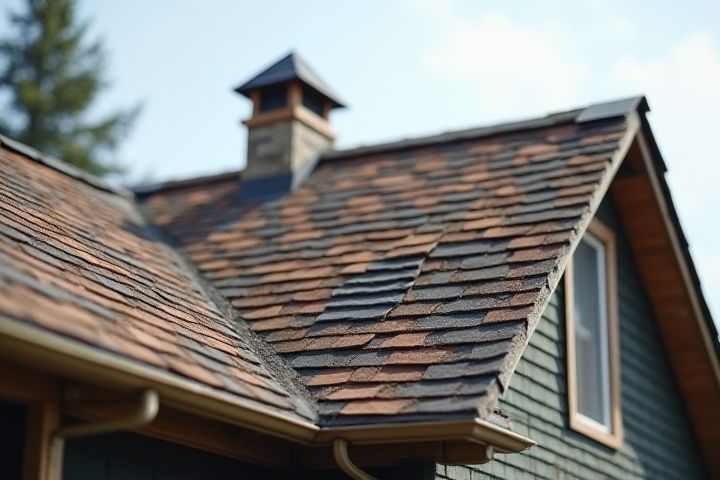
A roof replacement becomes necessary when shingles exhibit significant wear, such as curling, cracking, or missing pieces, indicating structural vulnerability. Signs of water damage, including stains on ceilings or walls, can signal leaks that compromise your home's integrity. Moreover, an increase in energy bills may point to inefficiencies in insulation or ventilation due to a deteriorating roof. Regular inspections, ideally conducted every three years or after severe weather events, can help you identify issues before they escalate. If you observe moss growth or sagging areas, it's essential to consult a roofing professional to assess whether a full replacement is needed for safety and performance.
When A House Requires A Roof Replacement
Frequent leaks and water damage
Frequent leaks can indicate underlying issues that necessitate a roof replacement, leading to extensive water damage in your home. Over time, inadequate roof performance may contribute to mold growth, structural weakening, and increased repair costs if not addressed promptly. Signs such as stained ceilings, peeling paint, and worn shingles signal that your roof may no longer effectively protect your property. Timely intervention can prevent further damage, save you money, and enhance your home's value.
Visible shingle deterioration
Visible shingle deterioration is a key indicator that your roof may need replacement. Look for signs such as cracked, curled, or missing shingles, which can compromise your home's integrity. Additionally, if granules from the shingles are collecting in your gutters, this may signal excessive wear. Timely action can save you from potential water damage and costly repairs, ensuring your home remains protected for decades.
Age of the roof
The age of your roof is a critical factor in determining whether it needs replacement, typically ranging from 20 to 30 years depending on materials used. Asphalt shingles, for instance, usually last about 15 to 30 years, while metal roofs can endure for over 50 years. Signs of wear, such as curling shingles, missing tiles, or leaks, often emerge after a roof reaches its lifespan. Regular inspections can help you assess the condition and prevent costly damages, ensuring your home remains protected from the elements.
Roof sagging or structural issues
Roof sagging, often indicative of structural issues, typically arises from water damage, snow accumulation, or inadequate support. The cost of roof replacement can average between $5,000 and $10,000, depending on materials and labor in your region. Signs of structural damage may include uneven rooflines, leaks, or visible rot, which can compromise the safety of your home. Knowing these key indicators can help you take proactive measures to ensure a timely and effective roof replacement.
Cracked or damaged flashing
Cracked or damaged flashing can lead to significant water intrusion and structural damage, making it a critical factor to assess when considering a roof replacement. Flashing, typically made of metal, protects vulnerable areas like joints, valleys, and chimneys from leaks. Addressing flashing issues promptly can prevent costly repairs, as water damage can escalate into mold growth and compromised insulation. For a robust and long-lasting roofing system, ensure your contractor checks the integrity of the flashing during the replacement process.
Granule loss on shingles
Granule loss on shingles is a critical indicator of roof degradation, often signaling the need for a replacement. You may observe that these granules are essential for protecting your shingles from harmful UV rays and weather-related damage, with an estimated lifespan of 20 to 30 years for asphalt shingles. If more than 15% of granules are worn away, it significantly reduces the shingles' effectiveness, leading to potential leaks and structural issues. Regular inspections, ideally every three years, can help catch this deterioration early, ensuring your home remains protected from the elements.
Moss or algae growth
Moss and algae growth on your roof can indicate underlying moisture issues, often leading to the need for a roof replacement. When these organisms thrive on your shingles, they trap moisture, which can accelerate deterioration and compromise the integrity of your roofing materials, potentially requiring replacement every 20 to 30 years. If left untreated, extensive moss or algae can void manufacturer warranties and result in costly repairs, sometimes exceeding $10,000. Regular inspections and preventative maintenance can help you avoid these expenses and extend your roof's lifespan by several years.
Increased energy bills
A roof replacement can significantly impact your energy efficiency, as outdated roofing materials may allow heat to escape during winter and increase cooling costs in summer. Homeowners might notice energy bills rising by 10-30% if their roofs lack proper insulation or ventilation. Upgrading to energy-efficient roofing options, such as reflective shingles or eco-friendly materials, can reduce your monthly expenses and improve comfort levels inside your home. Investing in a new roof not only enhances aesthetics but also promotes long-term savings on utility costs.
Daylight visible through roof boards
When you notice daylight visible through roof boards, it indicates a potential issue with your roofing system that requires immediate attention. This gap not only compromises your home's insulation but also exposes your interior to water leaks and pest infestations. A full roof replacement typically costs between $5,000 to $15,000, depending on your location and the materials used. Addressing this issue promptly not only protects your investment but also enhances your home's energy efficiency and overall curb appeal.
Missing or loose shingles
Inspect your roof regularly for missing or loose shingles, as these issues can lead to significant damage if unaddressed. Over time, shingles can become brittle, leading to a loss of around 20% of their protective capabilities. In the event of severe weather conditions, such as storms or high winds, the risk of leaks increases significantly when shingles are compromised. Ensuring a timely roof replacement can protect your home from potential repair costs, which can average between $5,000 and $10,000 depending on the size and materials used.
